Corn Rootworm Biology and Management
Written by Mark Jeschke, Ph.D., Agronomy Manager, Pioneer Agronomy Sciences
Written by Mark Jeschke, Ph.D., Agronomy Manager, Pioneer Agronomy Sciences
We may complain about 🥶, but winter plays a key role in killing off unwanted pests. So, how do factors like snow, freeze and moisture levels affect corn rootworm populations? Tune into Crop Doctorate to find out.
Corn rootworm has long been one of the most damaging insect pests of corn in North America. Both larvae and adults feed on corn plants and both are capable of causing economic levels of yield loss. Combined costs of corn rootworm control and lost yield from corn rootworm damage have historically been estimated to exceed $1 billion annually in the U.S.
Corn rootworms also have a history of adapting to and overcoming control tactics, which has increased the complexity and difficulty of successfully managing these pests, particularly in continuous corn production. Crop rotation, insecticides, and Bt traits have all been relied upon to manage corn rootworm at various points over the past several decades and have all proven susceptible to the evolution of resistant populations.
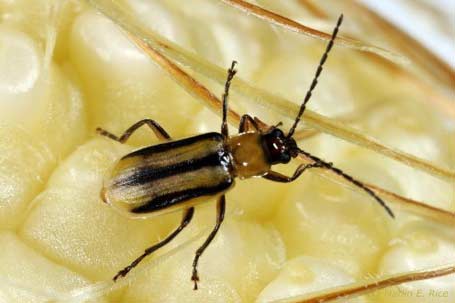
Western Corn Rootworm
Has three stripes, or one broad stripe, on the wing covers. The legs are partially black but not banded.ation of Earth’s greenhouse effect. Source: U.S. Energy Information Administration.
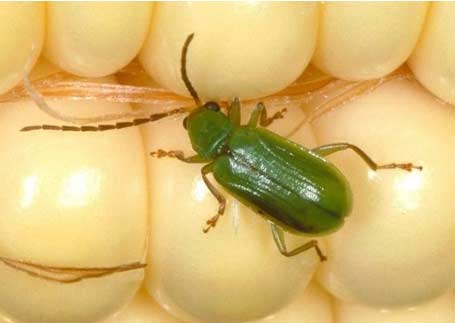
Northern Corn Rootworm
Solid green color. Newly emerged adults may be tan or light yellow in coloration. No stripes or spots on the wing covers.tion of Earth’s greenhouse effect. Source: U.S. Energy Information Administration.

Southern Corn Rootworm
Also known as the spotted cucumber beetle. Has a black head, green pronotum, and 12 black spots on the yellowish-green wing covers.tion of Earth’s greenhouse effect. Source: U.S. Energy Information Administration.
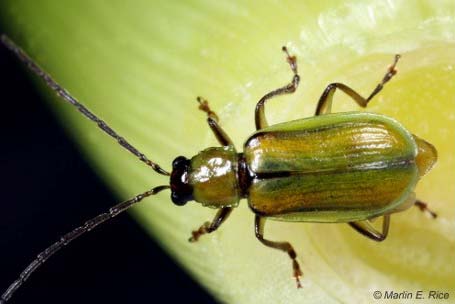
Mexican Corn Rootworm
Legs are dark colored. Wing covers are often a mixture of yellow, green, and light blue and lack distinctive stripes.
Figure 1. Rootworm species that can affect corn in North America.
Corn rootworms belong to the insect order Coleoptera, a massive order comprised of around 400,000 species. The genus Diabrotica consists of over 350 different species worldwide, including the four rootworm species that affect corn in North America (Figure 1). The western corn rootworm (Diabrotica virgifera virgifera) and northern corn rootworm (D. barberi) are the two most damaging species to corn in the Midwestern U.S. and in Canada (Figure 2). Both species can be found throughout much of the Corn Belt, often coexisting in the same fields (Figure 2). Mexican corn rootworm (D. virgifera zeae) is a pest of local importance in Oklahoma and Texas, and southern corn rootworm (D. undecimpunctata howardi), is found throughout the U.S., but rarely causes economic levels of damage
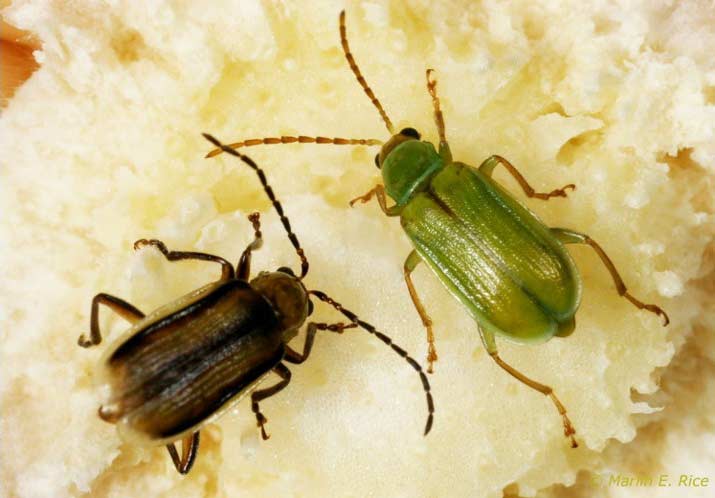
Figure 2. Western (left) and northern (right) corn rootworm are the two most economically important Diabrotica species in North America and coexist throughout the Corn Belt. Northern and western corn rootworm adults will feed on the same corn ears but may attempt to bite each other when they are in close proximity.
Western and northern corn rootworms have a history of adapting to and overcoming control practices, which has increased the complexity and difficulty of successfully managing these pests. Resistance to several classes of insecticides has been documented in populations of western corn rootworm, both to soil applications for larva control and foliar applications for adult control. Crop rotation was historically an effective and widely used management strategy; however, both species have developed adaptations that have challenged the effectiveness of soybean crop rotation in many areas.
A population of western corn rootworm, dubbed the “rotation-adapted variant”, developed the ability to defeat two-year corn-soybean crop rotations by laying its eggs in soybean fields rather than corn fields. Larvae hatch the following spring into the corn year of the rotation, allowing their survival. First discovered in eastern Illinois in 1987, this population quickly spread to Indiana, and eventually moved across the entire state to Ohio and Michigan counties (Figure 3). It also moved north and west in Illinois (Cook, et al., 2005), and can now be found in southern Wisconsin and eastern Iowa as well (Dunbar and Gassmann 2013, Prasifka et al., 2006).
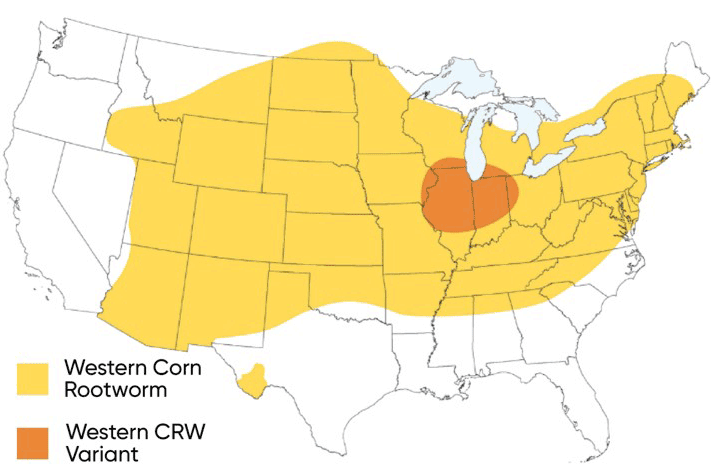
Figure 3. Approximate distribution of western corn rootworm and rotation-adapted variant populations.
Northern corn rootworm populations defeated rotation by a different adaptive mechanism – extended diapause. Diapause is a winter dormancy stage of rootworm eggs. Eggs exhibiting extended diapause remain viable in the soil for two or more years before hatching, allowing the insect population to survive until corn returns to the rotation. Instances of northern corn rootworm damage to corn grown in rotation with other crops was noted as far back as the 1930s, and research in the 1980s determined that extended diapause was the mechanism by which populations were able to survive and cause damage in rotated corn (Krysan et al., 1984). Rotation-resistant northern corn rootworms can now be found throughout much of the northern Corn Belt (Figure 4). Extended diapause can last up to four years and has shown adaptability to rotation patterns over time; i.e., fields with corn every other year have a relatively high percentage of eggs that hatch in the second year, and fields with corn every third year tend to have more eggs that hatch the third year, etc. (Levine et al. 1992).
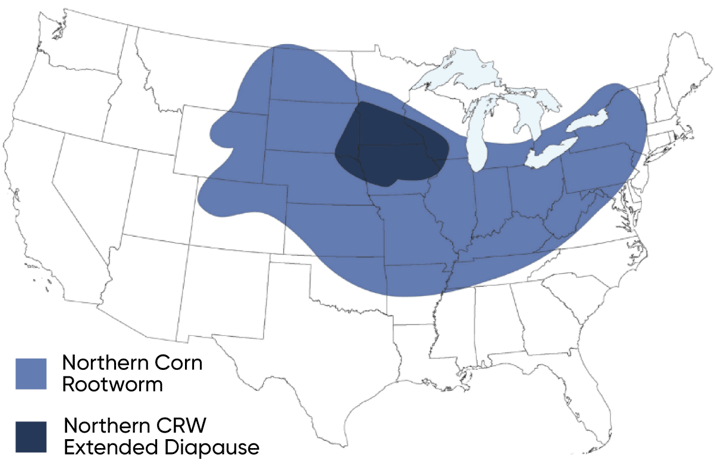
Figure 4. Approximate distribution of northern corn rootworm and extended diapause populations.
Cyclodiene insecticides were commonly used as soil treatments for the control of western and northern corn rootworms during the mid-20th Century. Populations of western corn rootworm resistant to this class of insecticides began to show up in the late 1950s and early 1960s (Ball and Weekman, 1962). After the failure of cyclodienes, organophosphate and carbamate insecticides became the predominant rootworm insecticides throughout the Corn Belt during the 1970s. Resistance to carbaryl and methyl parathion was confirmed during the 1990s. Resistance to organophosphate and carbamate active ingredients has been documented in both adults and larvae indicating that the metabolic mechanisms conferring resistance are present in all stages of life. In the 21st Century, pyrethroids became the primary insecticide class for corn rootworm control. Low-level resistance of a western corn rootworm population to pyrethroid insecticides was documented in 2019 (Souza et al., 2019).
Bt corn hybrids have been engineered to express genes isolated from the common soil bacterium Bacillus thuringiensis. The insecticidal properties of Bt were first recognized in 1901, and the use of Bt formulations as insecticides, which began in 1920 has continued to the present. Bt corn hybrids for European corn borer control were first commercially grown in the U.S. in 1996 and Bt hybrids designed to protect against corn rootworm larval feeding were introduced in 2003.
The potential for insect pest populations to become resistant to Bt was recognized before Bt corn entered the market, with the first instance reported in 1985 (McGaughey 1985). To reduce the probability of insects developing resistance to Bt corn, the Environmental Protection Agency (EPA) mandated certain provisions on the use of Bt corn products. One of the most important EPA requirements was that growers implement an IRM (insect resistance management) program, which includes planting a non-Bt insect refuge. The goal of a refuge is to ensure that susceptible insects are available in sufficient numbers to mate with any rare resistant survivors from Bt fields. Susceptible × resistant matings dilute resistance in the population and reduce the probability of building up resistant insect populations. This approach is most effective when the Bt trait delivers a “high-dose” of the Bt protein against the target pest, and the resistance gene in the pest population is inherited recessively.
The first case of field-evolved resistance of a corn rootworm population to a Bt trait was reported in 2011, when several fields in Iowa planted to hybrids expressing the Cry3Bb1 Bt protein experienced severe root injury from western corn rootworm larvae in fields (Gassmann et al., 2011). Cross resistance of these populations to the mCry3A Bt protein was documented in 2014 (Gassmann et al., 2014) and eCry3.1Ab Bt protein in 2016 (Zukoff et al., 2016). Reduced efficacy of the Cry 34/35Ab1 Bt protein for control of western corn rootworm was documented in Minnesota and Iowa beginning in 2013 Ludwick et al., 2017; Gassmann et al., 2016).
Western and northern corn rootworm complete one generation per year. Populations overwinter as eggs in the soil. Larvae hatch in the spring and go through three instars in the soil before they pupate and emerge as adults in mid-summer. After mating, females deposit eggs in the soil near the base of cornstalks where they will remain through the winter and hatch the following season.
Winter dormancy for eggs overwintering in the soil consists of two phases: obligate diapause and facultative quiescence (Krysan, 1978). Obligate diapause begins in the fall when embryonic development ceases in eggs that have been deposited in the soil. Embryos remain in this suspended state until diapause ends. The duration of diapause is genetically determined, hence the term obligate diapause, and not impacted by environmental conditions. Duration of diapause can vary widely across populations and among individuals within a population (Branson, 1976; Krysan, 1982).
Selection pressure imposed on corn rootworm populations will tend to select for individuals with a diapause duration that gives them the best chance for survival by timing hatch to correspond with food availability. This has been the case with extended diapause populations of northern corn rootworm in which repeated use of crop rotation as a means of control selected for individuals with a longer diapause period that would allow eggs to hatch when the field was rotated back to corn.
In the U.S. Corn Belt, the end of diapause often occurs sometime during the winter. At this point, dormancy enters the facultative quiescence phase, in which environmental conditions become the controlling factor. Embryonic development remains suspended until soil temperature increases above a threshold at which development can resume. In addition to the temperature threshold, eggs need to absorb water to complete development. If the surrounding soil is too dry, eggs will remain in a quiescent state until enough moisture is available to absorb for them to resume development.
The length of time between the end of facultative quiescence and egg hatch can vary based on soil temperature. In general, warmer and more consistent soil temperatures will enable faster embryonic development, with a constant temperature of 82°F (28°C) being ideal for development (Schaafsma et al., 1991). Numerous factors such as soil texture, tillage, and residue cover can influence the soil microenvironment and affect the timing of egg hatch. Rootworm egg hatch in the U.S. Corn Belt typically begins sometime between mid-May and early June and continues for around a month. Peak egg hatch may vary as much as 10-14 days from year to year based on differences in soil heat unit accumulation.
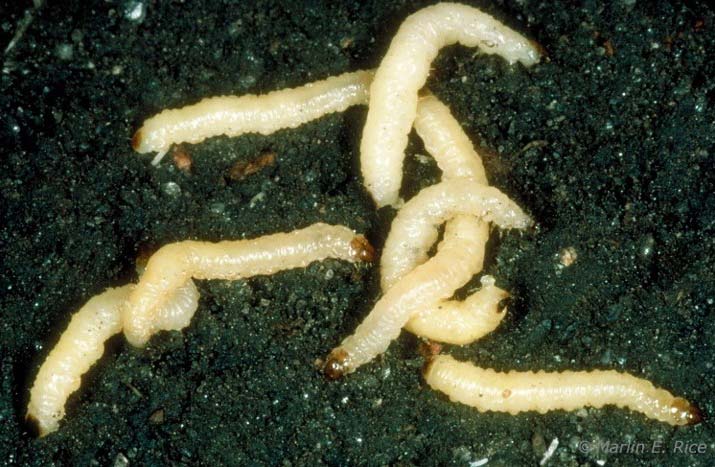
Figure 5. Corn rootworm larvae.
Newly hatched larvae are less than 1/8 inch (3 mm) in length and nearly colorless. Larvae have three pairs of legs behind their head capsule. All species of corn rootworm go through three instars during their larval stage. An instar is the period of growth between two molts. Molting is when a larva sheds its skin to allow it to grow larger. Corn rootworm larvae molt twice, with the molts separating the first and second instars, and second and third instars. Third instars are approximately 5/8 inch (16 mm) long and creamy white with a brown head and a brown plate on top of the last abdominal segment. At a constant temperature of 70°F (21°C), western corm rootworm first, second and third instars complete development in 6, 5, and 12 days, respectively. Northern corn rootworm development is somewhat longer, with first, second, and third instars completing development in 7, 7, and 19 days.
Newly hatched larvae are attracted by CO2 released from corn roots and are capable of moving up to 1.5 feet (0.46 m) in the soil to reach roots to feed on. Their ability to move through the soil can be limited by soil conditions. Corn rootworm larvae are small and soft-bodied, so they rely on pore spaces in the soil profile for movement. If pore space is restricted, such as in soil that has been compacted by wheel traffic, or highly saturated, larval movement will be reduced.
Larvae initially feed on root hairs and smaller portions of roots. As larvae develop, they feed externally and internally on larger roots. Larger larvae tend to move toward the center of the corn root mass, feeding heavily on newer root tissue, including brace roots. In cases where high feeding pressure creates intense competition among larvae for food, larvae may leave the plant on which they initially started feeding in search of another food source. Feeding is most extensive in early through mid-July in most regions of the Corn Belt.
After a larva has completed the three instars, it will form a small chamber in the soil in which it will pupate. This is a dormant stage during which no feeding takes place. The pupa stage lasts around 10 to 12 days as the larva transforms into an adult. Pupation success can be significantly reduced if soil is heavily saturated. Additionally, pupation success is reduced in soil types high in sand content, as larvae cannot successfully create a pupal chamber. Corn rootworm pupa are creamy white and partially translucent (Figure 6).
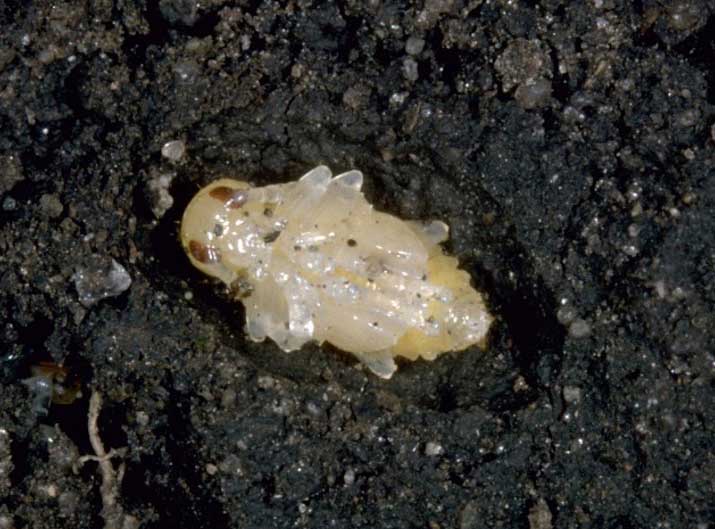
Figure 6. The corn rootworm larva makes an oval chamber in the soil, then it transforms into a pupa before later emerging as an adult.
Adult rootworm emergence begins in late July and may extend over several weeks. Typically, western corn rootworms emerge slightly ahead of northern corn rootworms, and males emerge slightly before females. Peak emergence in much of the Corn Belt will occur from the last week of July through mid-August. However, adult occurrence, feeding, and egg-laying in corn fields typically persists into September.
Females are sexually mature when they emerge and typically mate within a couple days of emergence. After mating, females will continue to feed in the field where they initially emerged for up to a week. Females have a pre-ovipositional period of about 14 days where they must feed to develop their eggs. Females tend to lay most of their eggs in their field of emergence. After a few days of feeding, mated female beetles may disperse to other fields where they will resume feeding. The likelihood and distance of dispersal from the home field can be influenced by larval density. Females emerging from fields with high larval density are more likely to disperse and tend to travel farther than females in fields with low larval density (Yu et al., 2019).
Northern corn rootworm adults are less likely to engage in long-range dispersal compared to western corn rootworms. Northern corn rootworm adults will frequently leave the cornfield to forage on flowering weeds and grasses but return to cornfields for oviposition.
Corn rootworm adults are strongly attracted to silking corn plants. Since corn plants in a field will not all silk at exactly the same time, the distribution of adults can shift around as they cluster on plants that are silking at a given time. This same phenomenon can be observed across fields as well, as adults migrate from earlier- to later-silking fields to continue feeding. Adults may also move into first-year corn fields where population levels and competition for food are likely to be lower. High densities of volunteer corn in soybean fields can attract corn rootworm adults, which can lead to rootworm pressure the following year if the field is rotated back into corn.
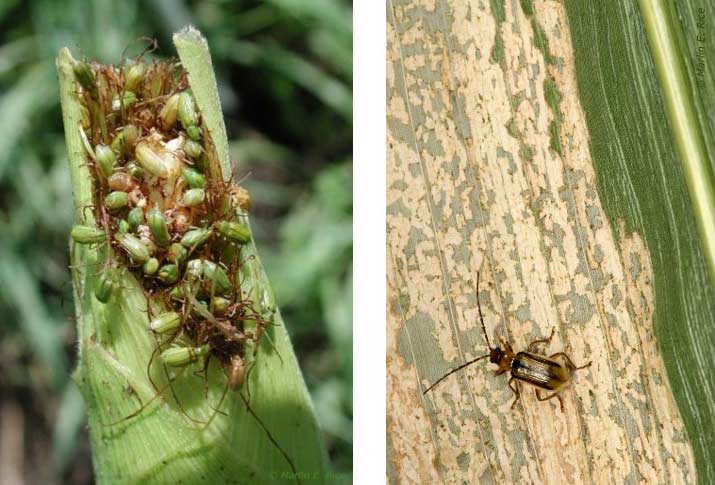
Figure 7. Left: Northern corn rootworm adults feeding on silks. Right: Western corn rootworm adult feeding on leaf tissue.
Rootworm adults primarily feed on corn silk and pollen. Adults may aggregate on corn ears and chew the silks off below the tip of the husk, thereby inhibiting pollination (Figure 7). Western corn rootworm adults may also feed on the soft epidermal tissue of leaves, especially if the tassel and silks have not yet emerged. Leaf feeding is usually minor, appearing sporadically in a field, and is unlikely to impact yield. However, extensive leaf feeding can be indicative of a large adult population that may cause problems when pollination begins.
Adults may also feed on other crops and weed species if it’s their best available option, particularly after corn pollination has ended. Corn rootworm adults are known to feed on soybean, sorghum, and alfalfa later in the growing season, as well as certain weed species (Figure 8).
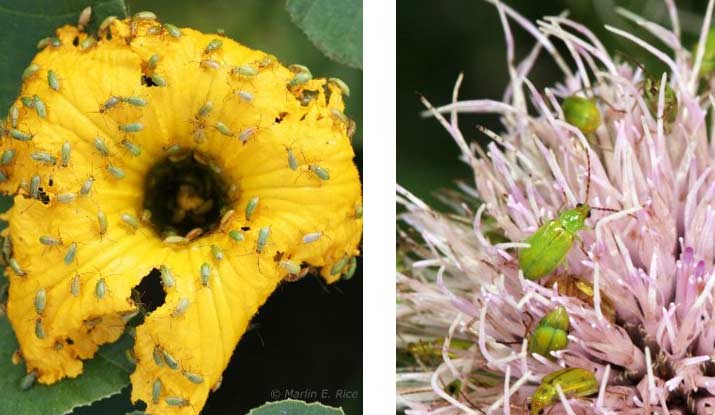
Figure 8. Corn rootworm adults will sometimes feed on flowers of other crop and weed species, such as yellow squash (left) and thistles (right).
The most commonly known and economically important case of corn rootworm adults feeding on an alternate host is that of the rotation-adapted variant of the western corn rootworm that feed and lay eggs in soybean fields. Variant populations are able to survive on soybean foliage and lay eggs in soybean fields due to evolved changes in gut enzymes and microbiota (Curzi et al., 2012). This adaptation does not allow eastern variant adults to thrive in soybean fields – they are only able to survive on soybean foliage for a few days and will commonly disperse in search of a better food source (Spencer et al., 2021). However, this adaptation extends the window of survival in soybean fields long enough for gravid females to deposit some of their eggs in the field before either departing or dying, establishing a population of corn rootworms in the field to infest corn planted the following season.
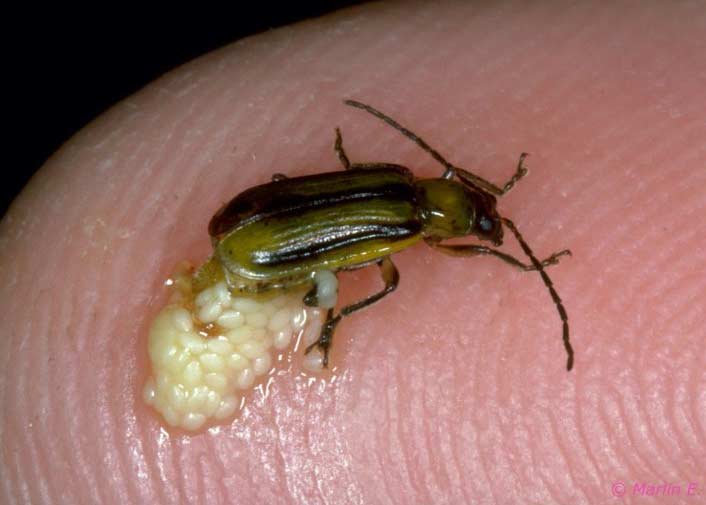
Figure 9. A western corn rootworm adult female with eggs.
Adult western and northern corn rootworms start laying eggs around two weeks after emergence, which is typically in August. Once egg laying begins, adult females will deposit most of their eggs over the next month in clutches of 50 to 80 eggs. During this time, females will alternate between depositing eggs in the soil and returning to the surface to feed, laying eggs approximately every five days (Hill, 1975). A single western corn rootworm female may deposit more than 1,000 eggs during its life (Branson and Johnson 1973; Hill 1975). Northern corn rootworm females do not produce as many eggs, laying approximately 300 in their lifetime (Naranjo and Sawyer 1987). Egg laying will continue until frost as long as temperatures are about 50°F (10°C).
Environmental factors over the course of the corn rootworm lifecycle can have a large effect on population levels. Like many other insect pests, it’s not unusual for populations to be higher in some years than others, and an increase in population compared to the prior year is not necessarily indicative of management failure but may just be a result of favorable conditions. Fluctuations in population density may go unnoticed unless they rise to the level of causing visible crop damage, typically when corn starts lodging during summer rainstorms. Scouting for larval activity early in the season and monitoring beetle densities later in the summer can be helpful in tracking corn rootworm population levels and allow management to be tailored accordingly (Figure 10).
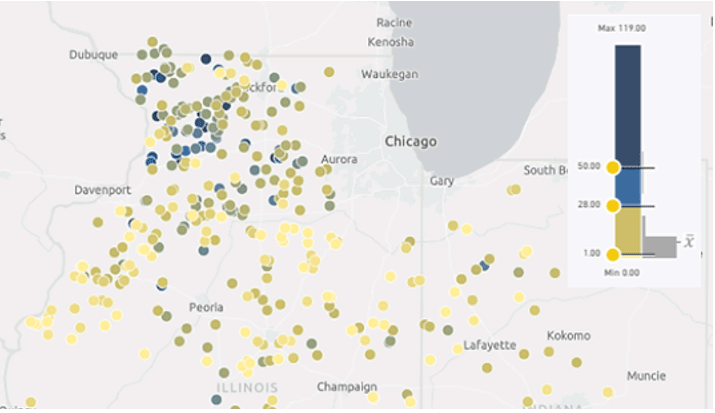
Figure 10. Moderate to high corn rootworm beetle trap counts across many locations in northwestern Illinois in 2020 indicated the potential for high larval feeding pressure in 2021, a forecast that turned out to be accurate.
The potential corn rootworm population level in a field for a given year is set by the number of eggs that hatch in the spring. The number of eggs deposited in the soil will depend in large part on the density of the corn rootworm adult population the previous year, so high adult populations can be an important warning sign of the potential for high larval feeding pressure the following year. However, environmental conditions during the fall at the time of egg laying and over the winter can have a substantial effect on egg mortality and population levels.
The proportion of corn rootworm eggs that are able to survive over the winter and successfully hatch in the spring is influenced by a number of factors, beginning with the soil condition at the time of egg laying in the fall. Gravid females will seek oviposition sites with optimal moisture conditions, which can be influenced by soil texture and residue cover. Egg laying can be spatially variable due to variation in soil texture and moisture levels throughout a field. Gravid females are not able to burrow in the soil, so they rely on already-existing openings in the soil, such as drought cracks and earthworm burrows, to move down in the soil to find suitable moisture levels. Most egg laying occurs 4-6 inches (10-15 cm) deep in the soil profile but under dry conditions may extend as deep as 8 inches (20 cm) for northern corn rootworm and 12 inches (30 cm) for western corn rootworm.
The depth at which eggs are deposited in the soil profile can affect their ability to survive the winter. Extreme cold temperatures and repeated freeze-thaw cycles can cause egg mortality. The deeper eggs are positioned in the soil, the more they will be buffered against fluctuations and extremes in air temperature. Soil texture and moisture can influence temperature buffering as well, as courser and drier soils have lower buffering ability than wetter and finer soils. Snow cover and crop residue can insulate the soil from extreme temperatures, which can result in higher overwinter survival.
All of these factors can produce spatial variation in overwintering survival across a field, as soil moisture, snow cover, and exposure to wind can vary based on soil texture and topography. Differences in overwinter survival mean that areas of a field with the greatest density of eggs during the fall will not necessarily be the areas with the most eggs that hatch in the spring. If larval feeding pressure during the summer appears to be relatively uniform across a field, it is likely indicative of a high level of winter survival that allowed larvae to establish throughout the field.
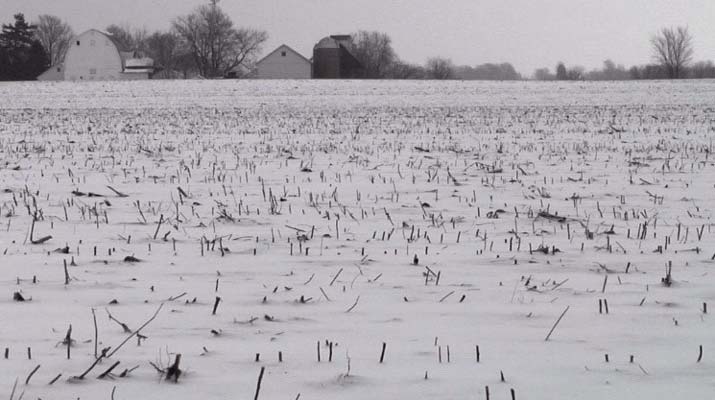
Figure 11. Snow cover insulates the soil from extreme temperatures, which can increase the survival of corn rootworm eggs overwintering in the soil.
Fall tillage does not appear to have a uniformly positive or negative impact on egg survival (Gray and Tollefson, 1988). Tillage redistributes eggs within the plow layer, which may move some eggs shallower in the soil where they are less likely to survive and some eggs deeper where they are more likely to survive.
Eggs of northern corn rootworm are more cold-tolerant than those of western corn rootworm, which is not surprising given its historically more northerly distribution. However, the continued trend toward warmer winter temperatures could allow western corn rootworm to become more dominant in the northern Corn Belt.
Just as environmental conditions can have a large impact on the survival of corn rootworm eggs over the winter, conditions during the spring can influence how many larvae are able to establish feeding and survive to adulthood. Newly hatched larvae have very limited mobility in the soil, so the ability to quickly find a proximal food source is essential to their survival. Larvae typically move through about 6 inches (15 cm) of soil to reach corn roots but can move up to 18 inches (46 cm) when necessary. If a newly hatched larva does not locate a suitable host within 24 hours, it is much less likely to survive (Branson 1989). As larvae grow, they redistribute, moving to younger root nodes that emerge from the stalk. Larvae may also redistribute to other plants when high larval density creates intense competition for food (Hibbard et al., 2004).
Soil conditions can affect the ability of corn rootworm larvae to reach corn roots to feed. Since larvae rely on soil pore space for travel, soils with high bulk density can restrict movement. Muck soils generally have lower incidence of rootworm larval feeding damage. Dry sandy soils can cause scratching and abrasion to larvae as they search for food causing them to lose moisture and die. Silty or loam soils provide the best environment for larvae to move in search of food and generally have a higher survival rate.
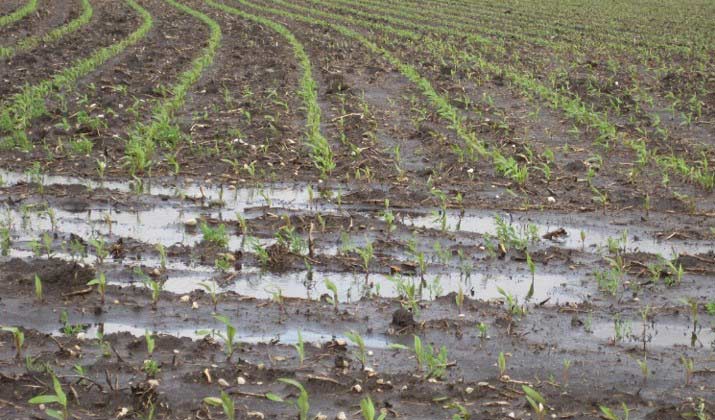
Figure 12. Soil saturation after corn rootworm eggs have hatched can dramatically reduce larval survival.
Soil saturation and flooding following corn rootworm hatch can dramatically reduce larval survival, causing larvae to either drown or be unable to locate corn roots for feeding (Riedell and Sutter, 1995). It’s not unusual for portions of a field that are saturated early in the season to have the least amount of root lodging later in the season when rootworm pressure is high. Survival rate is reduced when water is warmer. Larvae that have established feeding on corn root tissue are better able to survive short durations of saturation.
Of all the weather conditions that can affect corn rootworm population levels, flooding after hatch likely has the greatest potential to reduce populations. A wet spell during the spring can be helpful in lowering corn rootworm pressure. However, eggs that have not yet hatched are not greatly affected by soil saturation and hatch can extend for over a month, so the effect of soil saturation on the rootworm population will depend on its timing relative to peak rootworm hatch. Soil saturation that persists over a long enough duration to kill off a large proportion of the corn rootworm population may also be detrimental to early corn growth.
Somewhat counterintuitively, high corn rootworm larval density can be associated with lower adult populations. Multiple studies have shown that the proportion of the larval population that survives to adulthood can be density dependent, with percent adult emergence declining with higher larval densities (Hibbard et al., 2010). Greater larval density leads to more intense competition for food, reducing survival. Adults that do emerge in fields with high larval density are often smaller, shorter lived, and lay fewer eggs (Branson and Sutter, 1985). The survival rate of northern corn rootworm larvae to adulthood is generally lower than that of western corn rootworm (Onstad et al., 2006).
High corn rootworm populations can make management very challenging. No single tactic can be relied upon to provide complete protection against corn rootworm, however crop rotation, Bt traits, soil insecticides, insecticide seed treatments, and insecticide treatments targeted to adults can all be effective tools for managing corn rootworm populations when used as part of an integrated management strategy.
The first step for effective corn rootworm management is scouting fields to determine beetle population levels. This allows growers to make more informed decisions on tactics necessary to successfully manage corn rootworm the following season. Start scouting when silks appear in the field and continue weekly through grain fill. The fields with the highest likelihood of heavy corn rootworm pressure are continuous corn fields. Be aware that beetles can migrate to late planted fields, late CRM hybrids, and delayed maturity areas, creating very high localized populations.
Rootworm beetles are very attracted to fresh silks and will move and concentrate in fields where fresh silks are present. Timely treating of gravid or pregnant females can be very effective in reducing egg-laying and subsequent problems the following year. Rotation to a crop other than corn is still the single most effective way to counter corn rootworm resistance. Rotating out of corn at least 1 in 3 years or on 20% of total acreage annually can significantly reduce selection pressure and have a positive impact on resistance management.
Volunteer corn can serve as a host for corn rootworm beetles in soybeans. Controlling volunteer corn early will reduce this risk as well as competition with the soybean crop. Even in areas where rotation-resistant populations are present, crop rotation will still reduce selection pressure and may provide some benefit in reducing corn rootworm population levels.
The foregoing is provided for informational use only. Please contact your Pioneer sales professional for information and suggestions specific to your operation. Product performance is variable and depends on many factors such as moisture and heat stress, soil type, management practices and environmental stress as well as disease and pest pressures. Individual results may vary. Pioneer® brand products are provided subject to the terms and conditions of purchase which are part of the labeling and purchase documents.